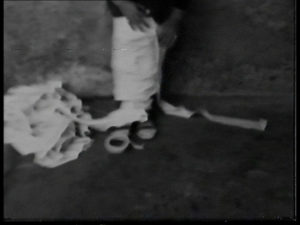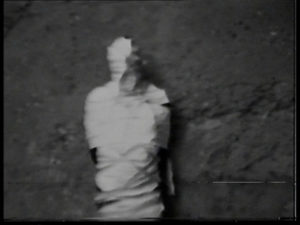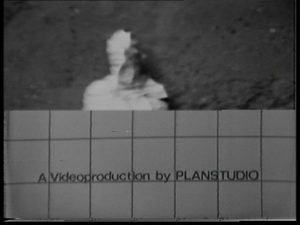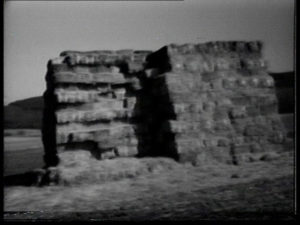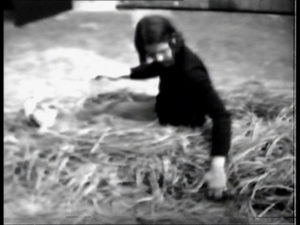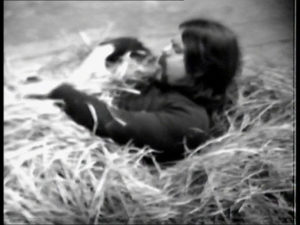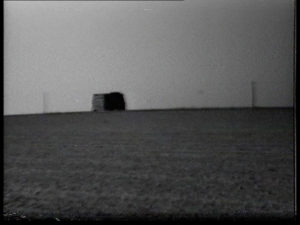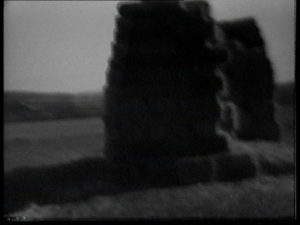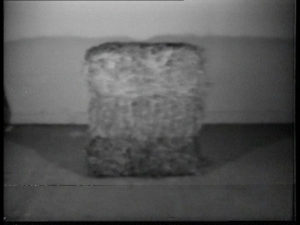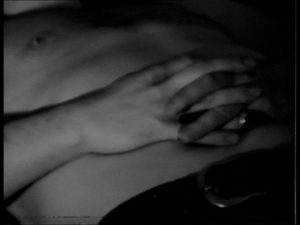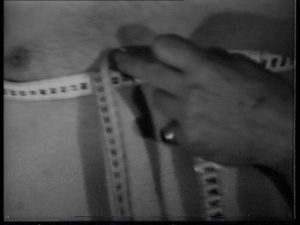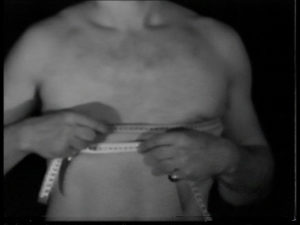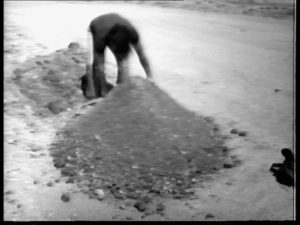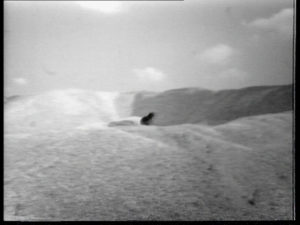Stefanie Schrank on
Planstudio Siepmann
Feel free to request further information and price lists regarding our wide range of products. Or come and visit PLANSTUDIO (please call for an appointment!). PLANSTUDIO is located between Cologne and Bonn in the Vorgebirge region, 20 minutes by car from Cologne and Bonn City.
This invitation was distributed by Ulla and Gerd Siepmann in the second half of the 1970s (for instance in announcements for coming exhibitions, as xeroxed info flyers, as well as in catalogues and magazines) and it is characteristic for the way Planstudio Siepmann worked: The wording seems a bit peculiar, reminiscent of advertising or marketing communication, but at the same time it contains witty humor and an enthusiasm for mass media and industrialization, and most of all it expresses an invitation to an encounter, a gesture both programmatic and genuine. The encounter they offered is meant as an encounter with interested and like-minded people, but also with nature itself, especially in regard to the location where the Siepmanns worked and lived, a former farm they had renovated in Bornheim-Merten, in the middle of the rural environs of Bonn, Germany’s capital at the time. Ulla Siepmann recalls that “nature as a theme was more common in the context of political activism. We dealt with gaps and fractures in an intense but subtle fashion that was more differentiated and enabled access to a meta-level. Not everyone was able to understand this, but this in turn always led to a very productive discourse.”[1]
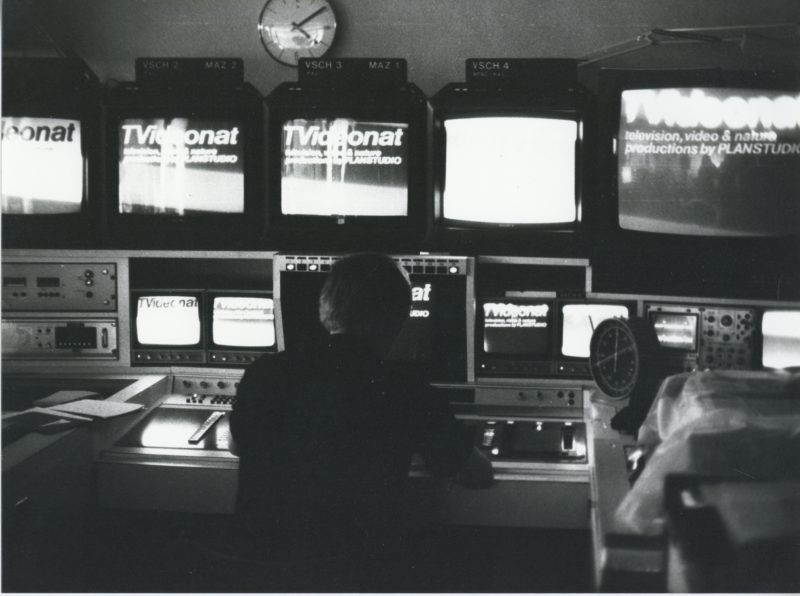
View into the editing studio at the Folkwang Museum during the production of videos by Planstudio Siepmann, 1975, photo: Ursula Siepmann, © Planstudio Siepmann
The above-mentioned “product range” includes photographs (often serialized), objects (for instance, organic substances such as grain, grasses, or stones presented behind Plexiglas[2]), models, plans, drawings, and videotapes, but also performances and multimedia installations. And of course the manifesto-like “Account by PLANSTUDIO on PLANSTUDIO” with the title In Search of Lost Nature, which came as a self-published booklet in A5 format. Therein, the Siepmanns explain their various areas of work and the underlying overall concept with images and typewritten text (with a rather idiosyncratic use of upper and lower case).[3]
This Search and its preliminary findings are repeatedly brought into exhibition spaces and other public locations in different forms aptly titled “nature preserves,” “intermedia nature-structures,” and “nature-plastic programs.” All of these are intended to provide a surrogate experience (“secondary reality”), as the “primary” experience of nature has become an almost impossible feat in urbanized spaces overcrowded with buildings and structures of all sorts.[4] A raised blind like the ones used for hunting—the central object of the large room installation at the Westfälische Kunstverein in Münster in 1977—becomes the metaphor for view and overview, gazes that are at once part of the event itself and also observe it. Already in the early seventies, the Siepmanns address the constant biological, climatic, and geological changes on planet Earth brought about by human activity,[5] a development we now refer to in terms of geological eras as the Anthropocene. “Irreversible damage caused by the destruction and deformation of the urban environs is the result of thinking and acting in ways that completely disregard nature.”[6] As a counter-position to these deformations that have arisen from unsustainable urban planning, the artists offer their own alternative strategies. After Gerd (1944–2013) and Ulla (*1946) Siepmann meet as students in the sixties[7] and become a couple, they start to collaborate artistically in 1972 as Planstudio Siepmann, a “deliberately matter-of-fact” moniker chosen due to the “multimedia nature of their collaboration.”[8]
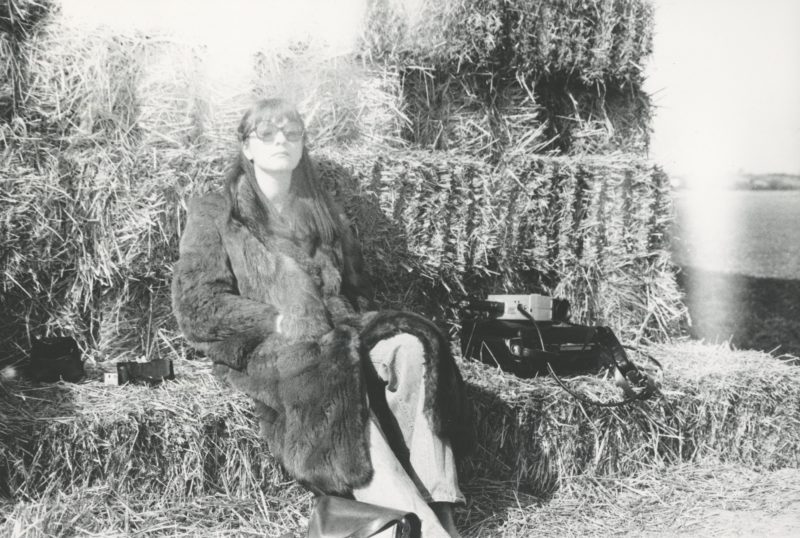
Ursula Siepmann on a harvest field in the Eifel region, 1975, photo: Gerd Siepmann
The activity of planning which inspired (and is implied by) the name is directed at trying to retrieve the cohesion of a fragmented environment that positions nature and culture as separate and even opposed (hostile) entities; the aim is to bring attention to this dichotomy through aestheticized settings where alienated spectators can come into contact with natural phenomena and, ideally, overcome the separation through intellectual-emotional confrontation: “PLANSTUDIO sees art as a destructive force.”[9]
For the Siepmanns, the ensuing interest in conceptual work, processes, and future perspectives can be expressed most appropriately in the form of pictorial sequences. Video soon becomes their preferred medium,[10] but even before they acquire a black-and-white video camera in 1973, the Siepmanns experiment with Super 8 film and slide projections. Photographic sequences (such as the documentation of a healing wound in Heilungsprozesse [Healing Processes], 1972) in black-and-white or as color Polaroid pictures are also an integral part of Planstudio’s toolbox from the outset, be it as standalone objects or as planning stages that precede (or are taken from) video pieces. A further decisive element of their artistic practice can be found in the texts and transcripts that accompany the mission—from a piece’s conception, to its installation, operation, and intended effect.
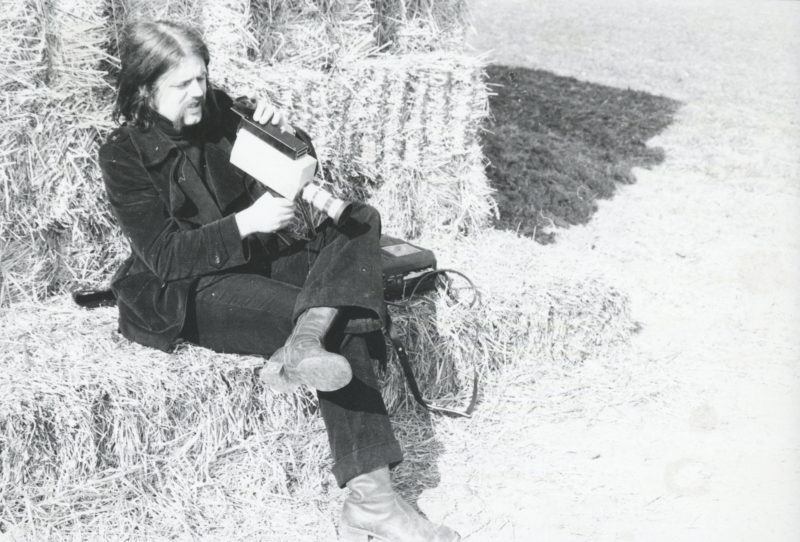
Gerd Siepmann on a harvest field in the Eifel region, 1975, photo: Ursula Siepmann
From 1965 on, Ulla and Gerd Siepmann live in Cologne’s Südstadt, the southern part of the city, and are part of the vibrant regional art scene, which includes for instance Ursula Wevers and Ingrid Oppenheim, early supporters of Cologne’s emerging video art scene in the seventies.[11] At Studio Oppenheim, Planstudio Siepmann stage their live-video performance Natur – ein mentaler Prozeß (Nature – a Mental Process) in 1974. Essen’s Folkwang Museum, with Germany’s first-ever museum section dedicated solely to video art, is a further key factor in geographical proximity supporting the new art form. Fittingly, a contribution by Planstudio is shown at the first “International Video Weeks Essen 1979”[12]; the following year, the Siepmanns produce Die Natürlichkeit der Natur: Von Yoghurt bis Bodybuilding (The Naturalness of Nature: From Yoghurt to Bodybuilding) at the museum’s video studio.[13] The core of the piece is a negotiation of TV commercials and their specific language in regards to the use of nature metaphors, as in the multi-part Nature News (beginning in 1976, for instance for Von der Plastik zur Handlungsform [From Sculpture to Form of Action], a series of video exhibitions curated in 1980/81 by Thomas Howeg at the Hochschule St. Gallen): During the performance, Siepmann recites collected slogans such as “a natural tan without sunlight,” “spicy tobaccos and a hint of natural menthol,” or “German food – all of nature’s variety” in a repetitive litany and thereby simultaneously reveals their suggestive power and how devoid of meaning they are.
Videoskizze Verpuppung, 1977, video stills © Planstudio Siepmann, VG Bild-Kunst, Bonn
While visiting an exhibition in Aachen in the mid-seventies, the Siepmanns meet Wolfgang Becker, founding director of the Neue Galerie Aachen (the predecessor of today’s Ludwig Forum), which leads to their collaboration in 1977. Becker also writes the preface to the most comprehensive Planstudio print publication to date.[14] All of the works that are now part of the Ludwig Forum’s archive are shown in the context of this exhibition; in addition, “Verpuppung” (see below) is performed live (to go with the exhibition, a video documentation of the performance is issued and sold at a price of ten Deutschmarks). In parallel, the Galerie an der Neupforte Aachen hosts “an exhibition of nature preserves and photographs by Planstudio Siepmann.”[15] In the subsequent years, Planstudio’s activities increase in frequency and reach, be it in the form of international solo exhibitions, participation in festivals and art fairs, video presentations, or live performances.[16]
“Verpuppung” (Pupation), a 9-minute recording which is part of Ludwig Forum’s archive, is a video sketch recorded in the Siepmanns’ studio space in Merten as a trial run of the pupation to determine whether and how quickly it is possible to realize.[17] In the beginning, the image shows Gerd Siepmann’s canvas-shod feet as well as his legs up to the middle of his thighs in front of a stone wall, next to him a pile of linen strips, each about a meter long and ten centimeters wide. The audio track consists of a monotonous engine noise. Siepmann, dressed entirely in black, starts at his ankles to wrap his own body with multiple layers of the white fabric, which he fastens with adhesive tape; the camera, operated by Ulla Siepmann, slowly follows his movements. Just below his armpits, his self-bandaging stops, Siepmann leans against the wall behind him and lowers his head, the camera follows his line of vision and then slowly moves back up. After a cut in the middle of this upward camera movement, his upper arms, shoulders, and head are now also wrapped in white linen; a motionless Siepmann maintains his upright pose, and the final credits begin.[18]
In its final form, the staging of the pupation was intended to last about 90 minutes; furthermore, the exposé specifies as requirements: “1 actor, video system, stereo amplifier, stereo tape, loudspeakers, lighting.”[19] An integral part of the performance is its recording and simultaneous broadcast in a second room of the exhibition. This way, “Verpuppung” illustrates how processes such as recording and playback become essential for the performative art piece as an assemblage of a multitude of visible and invisible components, and it does so in a symptomatic fashion, as the camera records and makes visible what the audience otherwise would not be able to see. The screen is in this sense a preselected framing and a prescribed perspective on the one hand, but on the other hand, it becomes a technological extension of the possible individual reception and reveals procedures and functions that are normally hidden.
What is characteristic for a “pupation,” or, respectively, its temporary result—the pupa—is, biologically speaking, an extreme inner transformation process, namely the complete bodily re-shaping of a being that for this purpose goes into spatial isolation (just like Siepmann during the performance). In the artistic practice of PLANSTUDIO and their pursuit of renewal, a transformation just as radical and profound towards an “advanced state of consciousness” is clearly a central objective.[20]
Die Kraft der Natur (Teil I), 1977, video stills © Planstudio Siepmann, VG Bild-Kunst, Bonn
Besides various forms of retreating into isolation, another prominent motif in several performances is the use of adhesive tape, as is also the case in the video piece Die Kraft der Natur (The Power of Nature). The merging of substance and objects on such a basic and material level by taping them together is in its simplicity a powerful metaphor for (1) taping in the sense of bandaging for medicinal and healing purposes and (2) connecting entities in the sense of a larger collective; accordingly, the complete title of the piece is Video-Performance: DIE KRAFT DER NATUR 1 – Verbindung aus Mensch und Stoff, Körper + Pflanzen (Video Performance: THE POWER OF NATURE 1 – Connection of Human and Fabric, Body + Plants). There are further similar performed connections in this series: in Die Kraft der Natur 2, for instance, Siepmann tapes, or rather connects himself to a tree.
The concept for the first part (included in the Ludwig collection) underlines the importance of a specific philosophical standpoint: this unity with nature or becoming one, as well as the proclaimed “being nature” as a counter-position to the human hubris of putting oneself “above nature”—a quasi-holistic position which is a direct consequence of overcoming and dissolving the clear-cut borders of entities and conditions:
“He begins covering himself with organic materials (…) until his skin as a boundary of physical existence (optical tangent or: inside and outside aren’t separated from each other) is no longer distinguishable from them (interdependency of the materials).”[21]
While the opening credits are rolling—as mentioned before and as in all the video pieces, these consist of a square grid with the signature “A Videoproduction by PLANSTUDIO” (the letters often slide downwards, in this case they are superimposed)—the audio track sets in: a male voice-over repeats “Die Kraft der Natur” (The Power of Nature), relentlessly and without expression. The camera shows Gerd Siepmann amassing more and more straw to build a pile the size of a reclining human body—reminiscent of an animal building a nest—until he finally sits down to rest on top of it. In a meticulous and accordingly slow process he covers himself with straw, beginning at his feet, wraps his body and fastens the straw with adhesive tape, while the camera focuses in narrow shots on the respective sections of his body he is currently working on. He continues wrapping and taping, and thus by extension “applying the second, material nature-skin,”[22] until he has rearranged the whole bundle in such a way that the human body is embedded in its center like a kernel.
Raum-Zeit-Selbsterfahrung, 1977, video stills © Planstudio Siepmann, VG Bild-Kunst, Bonn
Straw as a semanticized material[23] also plays a role in the two-part piece Raum-Zeit-Selbsterfahrung (Space-Time Self-Experience),[24] this time in the form of tightly packed hay bales, which the gaze of the performer and spectator gets closer to and then withdraws from again, however in different ways:
Part 1 was recorded on a harvested field near Merten/Trippelsdorf; a cubic object is positioned at the distant central point of the image, close to the horizon which runs along the image’s center. Approaching its subject at walking pace and in corresponding motion, the handheld camera produces a “self-made” zoom that lets the cube-shaped, quasi-architectural structure gradually become discernible as an accumulation of hay bales. Wind, the breathing of the person conducting the camera (Gerd Siepmann), and the sound of footsteps on the fallow land are audible. The closer Siepmann gets to his subject, the clearer the delicate textures and the openness of the structure become, which at first seemed rather closed. The hay bales are stacked on top of each other like building blocks, and the resulting cube was slightly reworked and rearranged sculpturally by the artists; several bales stick out and cause pronounced shadows, which in their contrast with the sunlit areas produce abstract shapes.
The camera starts circling the straw construction in an increasingly narrowing path until only details of the giant stack fill out the picture, suggesting a perspective reminiscent of patting down its surface and measuring it, until the camera begins to move away again. Up to this point, there hasn’t been a single cut, until after around 15 minutes the image changes to the second part, the “studio simulation.” A soundtrack consisting of abrasive engine noise is audible, while a single hay bale sits at the center of the image, the almost centered ”horizon” this time suggested by the contrasting edge of the white wall and the darker floor.[25] An almost imperceptible zoom sets in and brings the slightly upright hay bale closer to the spectator until the structure of the straw takes up the entire image. After an abrupt cut, part 2 is replayed. The meditative visual insistence on the subject can be seen as a pictorial strategy that rejects the conventions and possibilities of video as a medium characterized by moving images and time in order to demand a different perception. Especially Planstudio’s minimalist approach—depicting minimalistic acts in a minimalistic fashion and “not as a fascinating surrogate reality”—is intended to produce a “focus on the reflection of nature’s reality.”[26]
Ich atme, also bin ich, 1977, video stills © Planstudio Siepmann, VG Bild-Kunst, Bonn
Similarly, “Ich atme, also bin ich” (I breathe, therefore I am) subtly draws the spectators’ attention to functions and processes of the human body that are so mechanical that mostly they’re not perceived in an active and conscious manner, and thus the work reminds the spectators of their own bodily physicality. The two-part work uses the reference to Descartes’ “cogito ergo sum” while simultaneously abandoning such an intellect-based proof of existence to underline Planstudio’s phenomenological approach: not the cognition-oriented Thinking is the decisive precondition for the “I am,” for existence, for life, but rather the much more physical Breathing that precedes it. The first part shows Gerd Siepmann’s nude torso taking up the entire image diagonally from the top left to the bottom right corner of the picture, from his chest down to the waistband of his pants (with a belt).
His hands rest folded above his navel and are lifted and lowered corresponding to the breathing motion of the abdomen, which also causes the interlocked fingers to gradually glide apart in a relaxed manner: all of these movements are passive and not actively controlled and executed by the human mind. The second part features the same nude torso in an even narrower detail; this time the camera isn’t static and instead shifts slightly from left to right and finally a bit further away from its object, which lets the spectators now see the torso from the neck to the hips. Wrapped around the chest is a measuring tape, held together in front with both hands and repeatedly readjusted as its circumference changes, widens, and tightens in congruence with the breathing. Together with the audio track (deep breathing sounds), the focus lies on the movement of the chest, whose measuring ultimately won’t yield statistically utilizable results but instead is a more abstract measuring of life itself, which after all is facilitated by breathing.
Maulwurf, 1977, video stills © Planstudio Siepmann, VG Bild-Kunst, Bonn
At the beginning of Maulwurf (Mole), the aforementioned opening square grid disappears line by line in a downwards direction to reveal a piece of soil that takes up the entire picture; the image seems so devoid of motion that it could very well be a freeze frame. The sound of nearby traffic is audible. Only after four and a half minutes is earth shoveled from off-stage in clods of increasing size into the camera’s range. The traffic noise ceases and the steady scraping of a shovel becomes audible; the camera zooms out until Gerd Siepmann can be fully seen as he digs earth from the ground with a spade and shovels it onto a growing pile. The camera angle changes and unveils the landscape in which the excavation takes place: Siepmann is standing at the edge of a quarry. With the midday sun above him, he continues his monotonous labor in a decreasing tempo, albeit imperturbably and with significant physical effort, until the pile in front of him is almost chest high. A perspective shift after another cut then shows Siepmann from a side view, still shoveling between two piles the height of his hips while the camera slowly moves away from him. Siepmann by now is standing in a crater—due to the cut and the zooming out, the impression arises that the digger himself has dug the crater. The camera movement halts and, positioned at a distance, the protagonist as the center of the image pauses on a “giant stockpile in which he is now only discernible as a tiny object in total isolation,”[27] until the final credits grid moves in from the downside and finally covers him. This is another instance where the need to retreat is addressed, but also the merging and becoming one with organic substances, namely earth as “material” that in turn has the potential to be charged with nature-mythical meanings. Digging oneself in must be seen as parallel to the pupation, as a human need resulting from an assumed sensory overload in an environment that despite or because of this overabundance of impressions does not permit a first-hand experience of nature.
Even though activities such as digging, pupation, and isolating are metaphorically heavily charged and the materials used also carry specific connotations, at the same time it is impossible to overlook that the video performances by Planstudio Siepmann always contain an absurd, playful quality (for instance the obvious and almost Sisyphus-like futility of digging the hole) which adds a poetic lightness to their earnestness and didactics.
In 1982/83, Planstudio ceased its activities,[28] but: “nature was and remained the main focus throughout all of our life, only the media in which we negotiated it changed.”[29] Both Siepmanns involved themselves in new projects, among others the renovation of an old farmstead in the Eifel region, their home from 1982 on. Gerd Siepmann returned to painting and woodcut and dedicated time to cycling and his social activism. Within the rather short period of ten years, Planstudio Siepmann managed to produce an idiosyncratic body of video pieces whose inherent theoretical reflections on the potential of the medium as well as the questions they raise about a mindful relationship with nature, natural resources, and planned living environments still matter even four decades later and are as topical as ever.
[1] Ulla Siepmann interviewed in her studio by Miriam Lowack, March 17, 2016.
[2] The various materials they use are semanticized in a very consistent way, and (those) ascriptions and connotations are always openly explained, as the following quote shows: “The materials in use assume concrete meanings and become interdependent from each other. Plexiglas as material helps to illustrate this point: at first its function is strictly to conserve. In a next step, it allows visual access to the conserved organic materials and by opening them up to optical perception turns them into carriers of meaning while simultaneously making it impossible for a viewer to experience them on a haptic level. This move echoes the fact that the material as a primary reality has become almost non-existent for the spectator at this point.” In: Auf der Suche (see note 3), 9.
[3] Gerd and Ulla Siepmann (eds.), Auf der Suche nach der verlorenen Natur. Ein Bericht von PLANSTUDIO über PLANSTUDIO, 120 pages/ 186 illustrations, Bornheim–Merten 1977, edition of 500, special edition: 1–50 numbered and signed with two hand-developed photos sized 12×12 cm. Print: Mainz, Aachen.
[4] Ibid, 9.
[5] “Throughout the course of human history, there have never been more destructive interferences with nature than in the past decades. The ecological equilibrium is more and more affected by extreme human planning.” (In: Auf der Suche, 8).
[6] Ibid.
[7] Gerd Siepmann studied graphic design, painting, sculpture, and art history at the Werkkunstschule in Mainz, Aachen, and Cologne beginning in 1963; Ulla Siepmann was a student at the Pädagogische Hochschule (college of education) in Cologne from 1968–1972 and studied art, political sciences, philosophy, and psychology, with a focus on photography, film, and drawing. (Cf. studio interview, March 17, 2016).
[8] U. Siepmann in a letter to M. Lowack, May 23, 2015.
[9] Cf. statement in Kunstforum International, issue 28: “Künstlerehen” (artists’ marriages), 4/1978, 240.
The pieces are not only targeted at an inner movement in the recipients, but beyond that at an actual change in urban planning and environmental design: “The collective consciousness, especially that of those urban planners who mis-plan our environment, has to adapt to the needs of the individual = the natural being, if the unity of an environmental design which on the one hand respects nature and a legitimate technological-civilizational evolution on the other hand is to be accomplished. (…) They necessitate a mode of thinking that is both constructive and indebted to the environment and that participates actively in the field of environmental design going beyond an individual and mythologizing art practice.” (In: Auf der Suche, 10/11).
[10] “In the field between nature and (architecturally) developed space, video can become a message of primary nature experience. Information about nature’s existence (…) is accessible to a great number of recipients due to the possible mass distribution of video tapes and their broadcast via regular TV programs (development of a composite system of micro, meso, and macro videos).” (In: Planstudio Siepmann: “Video – vom elektronischen Medium zur Rückgewinnung der Natur,” in Richard Kriesche/ Radoslav Putar (eds.), Art, Artist & the Media (catalogue), Graz 1978.
[11] Cf. Wulf Herzogenrath on the beginnings of video exhibitions and distribution: “In Germany in the early 70s, there is Protection Ursula Wevers, Studio Oppenheim, both in Cologne, and P.A.P Hein in Munich.” In: Ars Viva 82/83 – Videokunst in Deutschland 1963–1982. Videobänder, Installationen, Objekte, Performances, Ostfildern 1982, 16.
[12] Numerous other artists who are now also included in the collection of Ludwig Forum Aachen likewise showed works there, such as Ulrike Rosenbach, Joan Jonas, Keith Sonnier, Bruce Nauman, and Richard Serra.
[13] Planstudio’s own video pieces at this point are produced under the header “TVideonat – television, video & nature.”
[14] Wolfgang Becker: “Aneignung von Natur: Mimesis oder Konsummation. Bemerkungen zum Planstudio Siepmann,” in: Auf der Suche, 5-7.
[15] Cf. the announcement for the exhibition at the Neue Galerie – Sammlung Ludwig 1977.
[16] Among others, 1977 at Westfälischer Kunstverein Münster and the State Ministry of Agriculture in Bonn; 1978/79 at Art–Internationale Expo in Basel; 1978 at Internationaal Cultureel Centrum Antwerp, Heidelberger Kunstverein, and in exhibition spaces and galleries in Zurich, Warsaw, Reykjavik, and Brussels; 1979 at Badischer Kunstverein Karlsruhe and Folkwang Museum Essen; 1980 at Hanover Art Museum with Sprengel Collection, as well as in locations in Alberta und Victoria, Canada; New York; and Minneapolis, USA; 1981 at Kunstverein St. Gallen, Lenbachhaus Munich, in Leiden, and many more.
[17] As a consequence of the test recording, longer pieces of fabric were used in the performance when it was staged in Aachen and Amsterdam, among other places.
[18] Both the opening and final credits in all the Siepmanns‘ video pieces use a square grid as basic design, which allows for a smooth transition between the individual videos. Due to this standardized design and the resulting possibility of combining and merging videos as required, they seem even more like single parts of a larger project.
[19] A description of the piece: In the presence of the audience, the protagonist of the performance is waiting in an otherwise empty room. Using adhesive tape, the floor has been subdivided into a square grid, and the steady roar of monotonous engine noise is fed into the room. From the original exposé: “After about 20 minutes, the actor starts to build a webbing throughout the room with pieces of white linen at a height of one meter. He starts in the corner facing the entrance and continues to build the web towards the door. Thus, the room gradually becomes inaccessible and the spectators are forced to leave it. In the meantime, the engine noise has increased. The visitor can either observe the further process of the performance in the adjoining room via a Life-broadcast (sic) or he can go upstairs in order to look into the performance room from there.” The camera position also changes and shifts from the center of the room (which at this point has been darkened) and gets closer to the spot-lit performer, who is positioned in a corner. Beginning at his feet and moving upwards from there, he wraps himself in pieces of linen just like in the video sketch until the pupation has been completed, and afterwards remains motionless for 20 minutes in his vertical cocoon.
[20] Auf der Suche, 83.
[21] Artists’ statement in Herbert Molderings (ed.), Natur und Kunst – Objekte, Installationen, Video, Münster 1977, 9.
[22] Ibid.
[23] To Ulla Siepmann, grain as a basic food for humans and animals is a “central element of life”; cf. studio interview. She also states: “The material offers information about the changes in a specific field, in a specific location: sowing, growing, decay, wind, oxygen, metabolic processes, rain, light, sun… The material is removed from the cycle and transformed into a carrier of meaning for a particular idea.” In: Natur und Kunst, 8.
[24] In the Münster catalogue, the first part is called Raumerfahrung – Selbsterfahrung (Spatial Experience – Self-Experience) and the second Studiosimulation.
[25] “A spatio-temporal shift takes place when the actor takes an element out of the whole (hay stack = problem area) and transports it to the interior, which is part of the constructed surrounding space.” Ibid.
[26] Artists’ statement in “Video – vom elektronischen Medium zur Rückgewinnung der Natur,” in: Art, Artist & the Media 1978.
[27] Natur und Kunst, 9.
[28] “Due to digitalization, video became an entirely different medium in the 1980s. Our semi-professional equipment would no longer have satisfied our demands.” Studio interview, March 17, 2016.
[29] Personal email, January 6, 2017.
